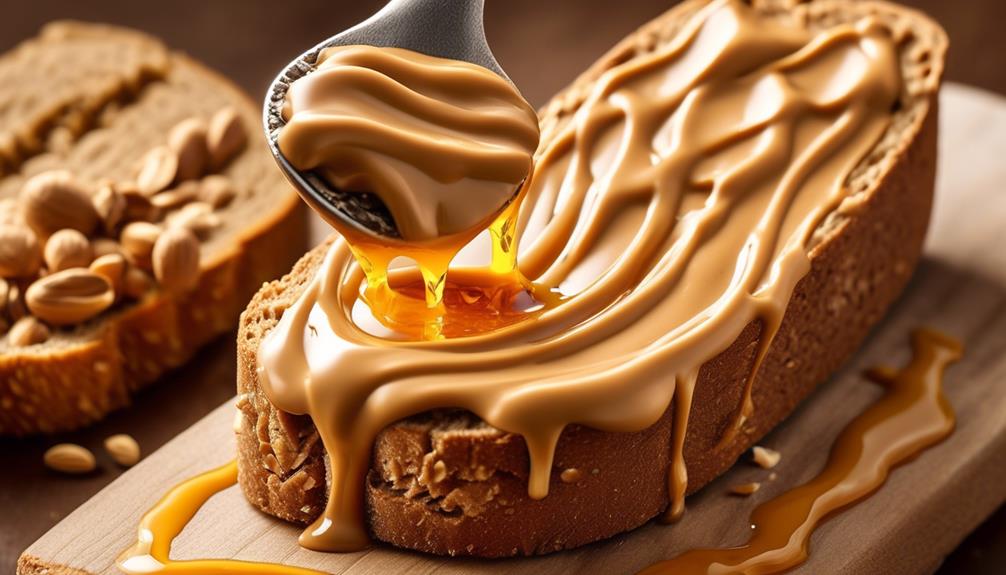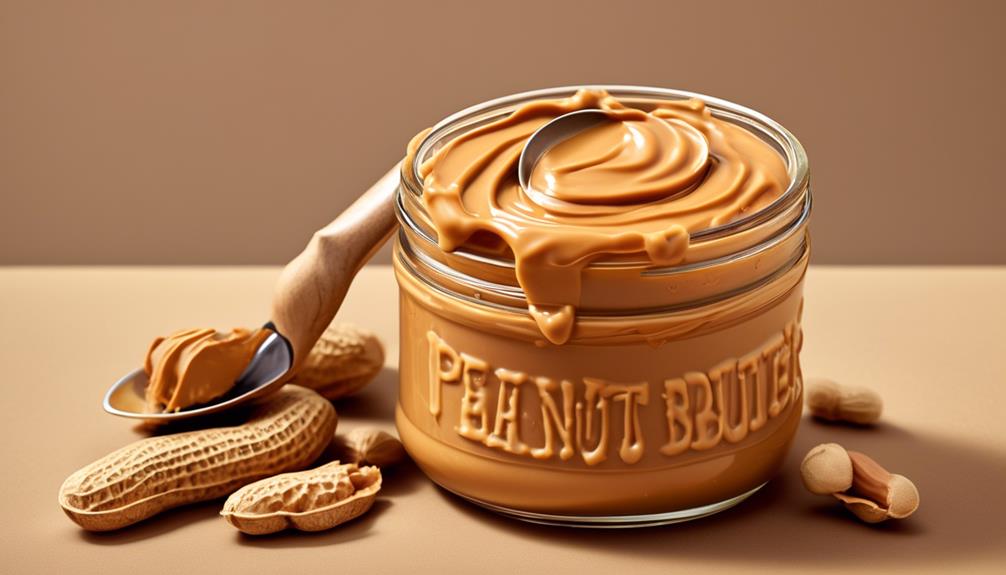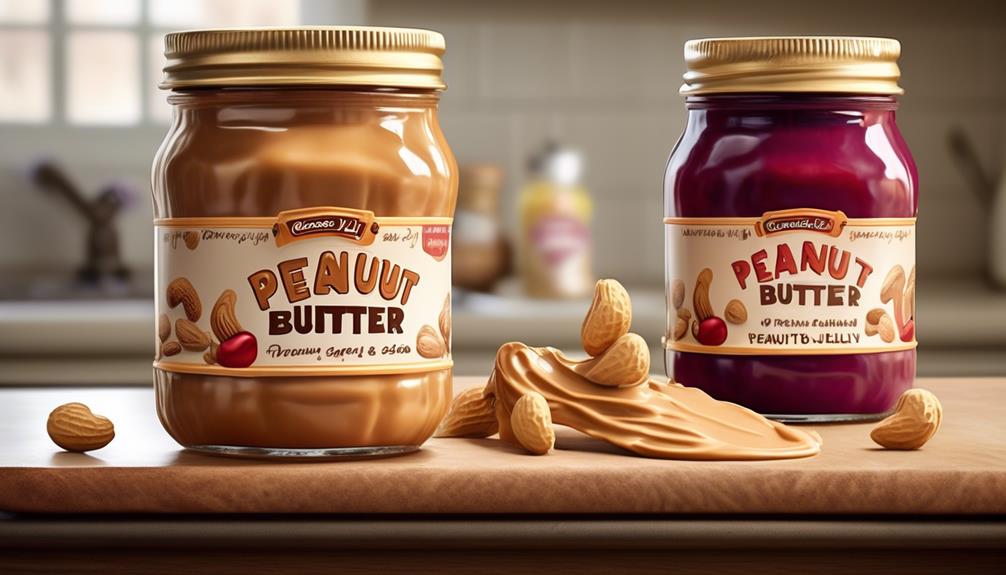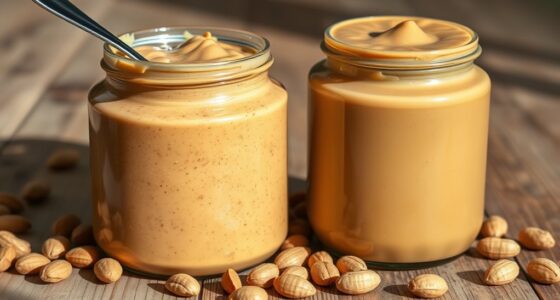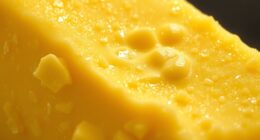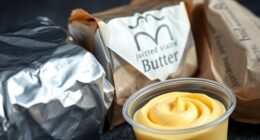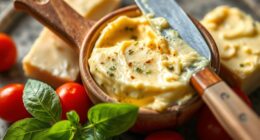Have you ever wondered why Americans eat around 700 million pounds of peanut butter every year? It’s just so darn tasty!
Well, it turns out that there's a lot more to the flavor of this popular spread than meets the eye. From the roasting process to the natural oils in peanuts, there are several factors that contribute to the delectable taste of peanut butter.
So, what exactly makes peanut butter taste so good?
Let's dig into the science behind this beloved spread and uncover the secrets of its irresistible flavor.
Key Takeaways
- Peanut butter flavor is influenced by the selection of peanuts and the roasting process, which triggers the Maillard reaction and creates rich, nutty flavors.
- The texture of peanut butter is determined by the grinding process, with fine grinding resulting in a creamy texture and coarser grinding yielding a chunky and crunchy texture.
- The addition of ingredients such as sweeteners, salt, and flavorings significantly influences the taste and texture of peanut butter, allowing for customization to meet consumer demands.
- Proper storage is crucial to maintain the taste and quality of peanut butter, as exposure to air, light, and high temperatures can lead to flavor changes and oxidation of fats.
History of Peanut Butter
The origins of peanut butter can be traced back to ancient cultures who ground roasted peanuts into a paste, creating a precursor to the modern peanut butter we enjoy today. Roasting the peanuts is a critical step in the process, enhancing the depth and richness of the flavor.
The history of peanut butter reveals a gradual evolution toward the natural peanut butter we've today. Companies have continuously improved processing techniques, using high-quality peanuts to produce a more delicious product. The taste of natural peanut butter varies depending on the brand and roasting methods employed during production.
The simplicity of natural peanut butter, made with just peanuts, natural oils, and proteins, without any additives or preservatives, allows the natural flavors to shine through. This history has led to the wide array of personal taste preferences, brand loyalty, and the different varieties of peanut butter available today.
Understanding the historical journey of peanut butter provides insight into the delicious and diverse flavors that we enjoy in the modern era.
Peanut Butter Production Process

We select high-quality peanuts and carefully roast them to develop flavor compounds through the Maillard reaction.
The University of Georgia has developed popular runner peanut varieties used in peanut butter production, known for their high oleic acid content that enhances flavor retention during storage.
The taste of peanut butter varies depending on the roasting process, natural oils in peanuts, and the absence of additives, allowing natural flavors to shine.
Peanut Selection Process
- Flavor and Oil Content: Peanut manufacturers carefully select peanuts based on their flavor and oil content to ensure the best taste and texture in peanut butter.
- Variety Selection: Certain peanut varieties, such as the runner varieties developed by the University of Georgia, are preferred for their ability to retain flavor during storage, contributing to the overall taste of peanut butter.
- Roasting Process: The roasting process is crucial in developing the rich, nutty flavor of peanuts for peanut butter. Through the Maillard reaction during roasting, flavor compounds are formed, enhancing the distinct taste of peanut butter.
In the peanut selection process for peanut butter production, the choice of peanuts, their variety, and the roasting process all play significant roles in delivering the best flavors.
Roasting and Grinding
Peanut selection and roasting play pivotal roles in the development of the rich, nutty flavor essential for high-quality peanut butter production. The roasting process is crucial as it triggers the Maillard reaction, creating key flavor compounds that contribute to the distinctive taste of peanut butter.
Manufacturers carefully choose peanut varieties, such as high oleic acid peanuts, to enhance flavor retention during storage, ensuring a longer-lasting rich taste. The development of popular runner peanut varieties, like those from the University of Georgia, has had a significant impact on the taste and production of peanut butters, making their flavors better than ever before.
The grinding process also significantly impacts the final product, as it affects the texture and consistency of the peanut butter. The natural oils in peanuts play a vital role in achieving the desired creamy texture.
Adding Ingredients
During the peanut butter production process, the addition of ingredients is a critical step that significantly influences the taste, texture, and nutritional composition of the final product.
- Roasted Flavor Development: The inclusion of roasted peanuts or roasted peanut paste adds a deep, nutty flavor to the peanut butter, enhancing its overall taste profile.
- Sweeteners and Salt: Controlled amounts of sweeteners and salt are added to balance the natural bitterness of peanuts and enhance the overall flavor.
- Stabilizers and Emulsifiers: Ingredients such as palm oil or hydrogenated vegetable oil are added to prevent oil separation and achieve a creamy texture, contributing to the mouthfeel and consistency of the peanut butter.
These carefully selected ingredients work in harmony to create the distinctive, rich taste and creamy texture that peanut butter enthusiasts enjoy.
Peanut Varieties and Flavor

Various peanut varieties significantly influence the diverse flavor profiles found in peanut butter. The taste of peanut butter can be attributed to the specific peanut varieties used and the roasting process. Peanuts with high oleic acid content, like the runner varieties developed by UGA, contribute to flavor retention in peanut butter. The natural oils in peanuts are crucial in shaping the taste and texture of peanut butter. The Smuckers brand, for example, uses specific peanut varieties to achieve its distinct flavor profile, while other brands may use different varieties resulting in varying flavors. According to research from the Kellogg School of Management, the roasting process also plays a pivotal role in enhancing the nutty, rich, and slightly sweet flavor of peanuts, which ultimately influences the flavor of peanut butter.
| Peanut Variety | Flavor Profile | Brand |
|---|---|---|
| High Oleic Runner Varieties | Enhanced flavor retention, nutty, and rich | Smuckers |
| Other Varieties | Varying flavors based on processing and type | Various brands |
| Roasted Peanuts | Nutty, rich, slightly sweet flavor | Kellogg Research |
Understanding the impact of peanut varieties and the roasting process provides insight into the complex flavors of peanut butter.
Roasting: Impact on Taste

When peanuts are roasted, they undergo chemical reactions that produce the rich, nutty aroma and flavor characteristic of peanut butter.
The Maillard reaction, in particular, creates compounds that contribute to the deliciousness of peanut butter.
Additionally, variations in peanut varieties and the roasting process play crucial roles in determining the final taste of peanut butter.
Roasting and Flavor
Roasting peanuts enhances their flavor by releasing natural oils and creating a rich, nutty taste profile. This process is crucial in the production of flavorful peanut butter. Here's how roasting impacts the flavor of peanuts:
- Formation of Flavour Compounds: Roasting triggers a series of chemical reactions that lead to the formation of compounds responsible for the characteristic nutty flavor of peanuts.
- Enhanced Aroma: The roasting process intensifies the aroma of peanuts, contributing to the overall sensory experience of peanut butter.
- Stable Flavor: Roasting also stabilizes the flavor of peanuts, making it more resistant to oxidation and prolonging the shelf life of peanut butter.
Understanding the impact of roasting on flavor allows us to appreciate the meticulous process behind creating the delectable taste of peanut butter.
Nutty Aroma
The impact of roasting on the flavor of peanuts extends to the development of a distinct nutty aroma, contributing to the overall sensory profile of peanut butter.
When peanuts are roasted, the Maillard reaction occurs, leading to the characteristic roasted peanut flavor and the creation of compounds that contribute to the nutty aroma.
This aroma is a key component of the rich, creamy taste of peanut butter, enhancing its sensory appeal.
For instance, Smuckers, a renowned peanut butter brand, carefully roasts their peanuts to achieve a delightful nutty aroma that enhances the overall flavor profile of their product.
The aroma, coupled with the creamy texture and slightly sweet taste, creates a satisfying sensory experience.
Through advancements in production techniques and the selection of high-quality peanuts, the nutty aroma of peanut butter has continued to evolve, meeting the demands of discerning consumers.
Grinding and Texture

Peanut butter's delectable taste and creamy consistency are achieved through the grinding process, which transforms roasted peanuts into a smooth and spreadable texture. The grinding process is crucial in determining the final texture and flavor profile of peanut butter. Here's how it works:
- Grinding: The roasted peanuts are ground into a fine paste, releasing their natural oils and flavors. The grinding action breaks down the peanuts into tiny particles, creating a smooth and velvety texture that's characteristic of peanut butter.
- Texture: The grinding process determines the texture of the peanut butter. Fine grinding results in a creamy and smooth texture, while coarser grinding yields a chunky and crunchy peanut butter. This variability in texture allows for a diverse range of options to cater to different preferences.
- Roasted Flavor: Through grinding, the roasted flavor of the peanuts is intensified, contributing to the rich and nutty taste of peanut butter. The grinding process ensures that the natural oils and flavors are evenly distributed, resulting in a consistently delicious product.
Understanding the grinding process provides insight into the art and science of creating the perfect peanut butter with its desired texture and roasted flavor.
Salt: Taste Enhancer

Salt, as a versatile taste enhancer, plays a crucial role in amplifying and balancing the flavors present in various culinary creations. When it comes to peanut butter, salt serves as a key component in enhancing its taste. The addition of salt not only brings out the natural sweetness of the peanuts but also helps in balancing the overall flavor profile. In the case of peanut butter, salt acts as a flavor enhancer, making the nutty taste more pronounced and enjoyable.
Furthermore, salt can contribute to the development of a roasted flavor in peanut butter. When peanuts are roasted, the Maillard reaction occurs, resulting in the development of complex, savory flavors. Salt can accentuate these flavors, adding depth and richness to the peanut butter. Additionally, salt can suppress any potential bitterness in the peanuts, resulting in a more pleasant overall flavor.
It is essential to note that the role of salt as a taste enhancer isn't limited to peanut butter alone. Salt is a versatile ingredient used in a wide variety of cuisines and dishes worldwide, where it serves to elevate and balance flavors, making food more enjoyable and satisfying.
Sweeteners and Flavorings

Commonly utilized in a wide array of food and beverage products, sweeteners and flavorings play a pivotal role in enhancing taste and palatability.
1) Artificial sweeteners, such as aspartame and sucralose, provide sweetness without adding calories, making them popular in low-calorie or sugar-free peanut butter products.
2) Natural sweeteners like honey, maple syrup, and stevia are sought after for their perceived health benefits and more natural appeal, often used to sweeten organic or all-natural peanut butter variations.
3) Vanilla, cinnamon, and citrus extracts are popular flavorings used to impart characteristic tastes and aromas to a wide range of peanut butter products, catering to diverse consumer preferences.
The use of sweeteners and flavorings allows for the customization of taste profiles, meeting consumer demands for unique and appealing peanut butter options.
Nutritional Factors

When considering the nutritional aspects of peanut butter, it's important to assess its role as a source of essential nutrients and its potential impact on overall dietary intake. Peanut butter is a nutritional powerhouse, packed with protein, healthy fats, fiber, and potassium. The monounsaturated fats it contains are particularly beneficial for heart health. Opting for natural peanut butter without added sugars, salts, or oils can further enhance its nutritional value, making it a dense choice for vital nutrients. It's also worth noting that different varieties and flavors of peanut butter offer diverse nutritional profiles, so consumers have the opportunity to tailor their selection based on specific dietary needs. When it comes to stability, the roasted flavor of peanut butter adds to its appeal, providing a satisfying taste while maintaining its nutritional integrity. Considering these nutritional factors, it's evident that peanut butter is not only a delicious option but also a valuable addition to a well-rounded diet.
| Nutrient | Benefits |
|---|---|
| Protein | Muscle repair and growth |
| Healthy Fats | Heart health |
| Fiber | Digestive health |
| Potassium | Blood pressure regulation |
| Monounsaturated Fats | Cholesterol maintenance |
Chemical Composition of Peanut Butter

As we consider the nutritional benefits of peanut butter, it's essential to understand its chemical composition, which encompasses the fundamental elements that contribute to its unique characteristics and flavor profile.
Peanut butter is primarily composed of peanuts, oil, and salt, with variations in additional ingredients such as sugar or sweeteners. The chemical composition includes proteins, fats, carbohydrates, and micronutrients present in peanuts and added oils.
The roasting process of peanuts in peanut butter production leads to the Maillard reaction, creating flavor compounds and contributing to its distinctive taste. Additionally, the type of peanuts used, such as runner varieties with high oleic acid, can influence the chemical composition and flavor retention of peanut butter.
Moreover, the absence of additives and preservatives in natural peanut butter allows the natural chemical composition and flavors of peanuts to stand out. Understanding the chemical composition of peanut butter is vital not only for its taste but also for aspects such as stability to oxidation, roasted flavor, and effective brand communications.
Taste Preferences Across Cultures

Culturally influenced taste preferences play a significant role in shaping individuals' inclinations towards specific flavor profiles. The way we perceive and appreciate taste is deeply rooted in our cultural background. For example, in some cultures, there's a strong preference for savory and salty flavors, while in others, sweetness is highly valued.
This diversity in taste preferences is reflected in the varying popularity of peanut butter across different cultures. In cultures where peanuts are a common ingredient in traditional dishes, the taste for peanut butter tends to be more prevalent.
Additionally, the significance of certain flavors in cultural ceremonies, celebrations, and rituals can further shape taste preferences. In understanding taste preferences across cultures, it's crucial for brand communications to consider the cultural nuances that influence flavor retention and appreciation.
Nutty Flavor: Chemical Compounds

We've discovered that the nutty flavor in peanut butter is a result of specific chemical compounds like pyrazines and furans. These compounds, formed during the roasting process, play a crucial role in creating the characteristic nutty aroma and flavor of peanuts.
Additionally, compounds such as 2-acetyl-1-pyrroline and 2-methyl-3-furanthiol intensify the nutty and roasted flavors in peanut butter, providing valuable insights into the science behind its delicious taste.
Flavor Compounds in Peanuts
The development of the nutty flavor in peanuts and subsequently in peanut butter is intricately linked to the formation of specific chemical compounds during the roasting process. When peanuts undergo roasting, a series of complex chemical reactions occur, leading to the creation of flavor compounds that contribute to the rich, roasted flavor characteristic of peanut butter.
These compounds include Maillard reaction products, which impart a deep, savory taste, and volatile compounds that give peanuts their distinct aroma. The careful selection of peanut varieties, such as UGA's runner varieties with high oleic acid, further enhances flavor retention and taste.
The brand communications of companies like Kellogg and Smuckers Natural Peanut Butter often emphasize the natural oils and roasting process that contribute to the product's rich and satisfying flavor.
Aroma and Taste Perception
Chemical compounds such as pyrazines, furans, and phenols play a crucial role in shaping the distinctive nutty aroma and taste of peanut butter.
Pyrazines, responsible for the roasted, nutty scent, are formed during the Maillard reaction in peanut roasting. This reaction also produces furans, enhancing the nutty and caramel-like flavors.
Additionally, phenols present in peanuts contribute to the overall nutty taste and aroma in peanut butter. When we consume peanut butter, our taste perception is influenced by these compounds, which create the familiar nutty flavor.
Understanding the specific chemical compounds behind peanut butter's flavor is vital for brand communications and product development, allowing for precise descriptions of the product's aroma and taste.
Mouthfeel and Sensory Experience

In a sensory study conducted by researchers, the unique mouthfeel of peanut butter has been attributed to its ability to coat the tongue and palate, creating a creamy and rich sensation. This mouth-coating characteristic is a significant contributor to the overall sensory experience of peanut butter, complementing its roasted flavor and enhancing taste perception.
Here's how the mouthfeel of peanut butter influences our sensory experience:
- Viscosity: The thickness and stickiness of peanut butter contribute to its mouth-coating sensation, which influences how the flavor compounds are released and perceived by the taste receptors on the tongue.
- Creaminess: The high fat content in peanut butter contributes to its creamy mouthfeel, providing a smooth and indulgent sensory experience that lingers on the palate.
- Palate Resonance: Peanut butter's ability to linger on the palate allows for a prolonged sensory experience, enhancing the perception of its roasted flavor and contributing to the overall enjoyment of its taste.
Understanding the intricate relationship between mouthfeel and sensory experience can deepen our appreciation for the nuanced flavors and textures of peanut butter, making it a truly delightful culinary experience.
Shelf Life and Taste Changes

When it comes to peanut butter, shelf life can significantly impact its taste.
Exposure to air, light, and high temperatures can hasten the degradation of flavors over time.
Proper storage and consumption within the recommended time frame are crucial to maintaining the original taste of peanut butter.
Shelf Life Impact
Peanut butter's shelf life can impact its taste, as exposure to oxygen and light can lead to oxidation of the fats, causing rancidity and a noticeable change in flavor over time. This oxidation process can result in a loss of the desirable roasted flavor and stability of the peanut butter.
Factors that contribute to the shelf life impact on taste include:
- Storage Conditions: Proper storage in a cool, dark place can help slow down the oxidation process, preserving the flavor for a longer period.
- Packaging: The type of packaging used can affect the exposure of the peanut butter to oxygen and light, thereby influencing its shelf life and taste.
- Quality of Ingredients: The quality of the peanuts and other ingredients used in the production of peanut butter can impact its susceptibility to oxidation and subsequent changes in taste.
Understanding these factors can help consumers make informed choices to maintain the quality and taste of their peanut butter.
Flavors Over Time
Understanding the impact of shelf life on peanut butter's taste leads us to explore the changes in flavors over time, shedding light on how oxidation affects its sensory characteristics. Over time, peanut butter can undergo flavor changes due to oxidation, which can alter its sensory profile. The table below outlines the typical changes in peanut butter flavors over time.
| Time | Flavor Changes |
|---|---|
| Fresh | Rich, roasted flavor |
| 3-6 months | Slight decrease in roasted flavor, stable to oxidation |
| 6-12 months | Noticeable decrease in roasted flavor, slight increase in bitterness |
These changes are important for brand communications and consumer education about the stability of peanut butter flavors over time. By understanding these flavor changes, consumers can make informed decisions about the shelf life of their peanut butter and enjoy it at its best.
Storage and Taste
Proper storage conditions play a crucial role in maintaining the taste and quality of peanut butter over time. Storing peanut butter away from heat and light is essential to prevent oxidation, which can alter its flavors. Additionally, potential rancidity can impact the taste of peanut butter over time.
Refrigeration can extend the shelf life of natural peanut butter, but it may also affect its texture and taste. Thus, storing peanut butter in a cool, dark place and consuming it within its recommended shelf life can help preserve its taste.
It's important to pay attention to storage instructions on the packaging to ensure optimal taste retention and to follow brand communications regarding the storage of peanut butter.
Future Trends in Peanut Butter Flavor

In exploring the future trends in peanut butter flavor, researchers are observing a growing consumer preference for innovative and diverse taste profiles. As consumer palates evolve, the demand for unique and adventurous peanut butter flavors continues to increase. To cater to this trend, companies are investing in extensive research and development to bring new and exciting flavors to the market. This shift in consumer preferences has led to a reevaluation of marketing strategies within the peanut butter industry, with a focus on promoting the sensory experience and emotional connection that innovative flavors can evoke.
| Flavor Profiles | Description | Potential Appeal |
|---|---|---|
| Spicy Peanut Butter | Infused with chili, cayenne, or other spices for a bold kick | Appeals to adventurous consumers seeking new taste experiences |
| Sweet and Savory | Combination of peanut butter with sweet and savory elements such as honey, sea salt, or caramel | Attracts those looking for a versatile spread for both sweet and savory dishes |
| Global Fusion | Fusion of peanut butter with international flavors like matcha, coconut, or cardamom | Appeals to a diverse audience with a taste for global cuisine |
These emerging flavor profiles showcase the potential for peanut butter to evolve and adapt to changing consumer preferences, setting the stage for a dynamic future in the world of nut butter.
Frequently Asked Questions
How Is the Taste of Peanut Butter?
The taste of peanut butter is a delightful blend of creamy, nutty, and slightly sweet flavors. It can vary based on the brand and roasting process, with the Maillard reaction contributing to its complex flavor compounds.
Advancements in production techniques and the use of high-quality peanuts have improved natural peanut butter's taste over the years. The simplicity of natural peanut butter, including its natural oils and proteins, also plays a role in its delicious taste.
What Gives Peanut Butter Its Flavor?
Peanut butter gets its flavor from the roasting process, which brings out the rich, nutty taste, and the natural oils that contribute to its creamy texture. The selection of peanut varieties and roasting techniques also influence the flavor profile.
Additives and preservatives in some types of peanut butter can alter the taste, while personal preferences and brand loyalty play a significant role in how individuals perceive its flavor.
Why Is Peanut Butter so Delicious?
We find peanut butter delicious due to a combination of factors.
Its rich, nutty flavor, creamy texture, and slightly sweet taste appeal to our taste buds.
Additionally, the high fat and protein content in peanut butter triggers a satisfying sensation in our brains.
The roasting process also enhances the nutty flavor and creates Maillard reaction products, which contribute to its deliciousness.
These factors make peanut butter a highly enjoyable and satisfying food for many people.
Is It Normal to Not Like Peanut Butter?
It's normal for tastes to vary, and not everyone enjoys peanut butter. Several factors, such as individual preferences, allergies, and dietary restrictions, influence one's liking or disliking of it.
Our tastes are shaped by a combination of genetic and environmental factors. So, it's perfectly normal for some of us not to like peanut butter. It's all about personal preference and what suits our unique palate.
Conclusion
In conclusion, the rich and satisfying flavor of peanut butter is the result of the roasting process, the natural oils in peanuts, and advancements in production techniques.
The nutty, slightly sweet taste and creamy texture make peanut butter a beloved staple in many households.
As we continue to innovate and improve peanut butter production, we can look forward to even more delicious and satisfying flavors in the future.
